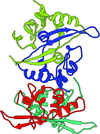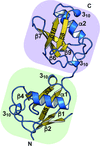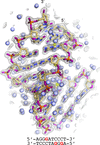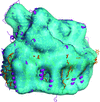issue contents
January 2019 issue

Cover illustration: Iron-sulfur clusters have no right angles [Moriarty & Adams (2019), Acta Cryst. D75, 16-20]. Representations of the Fe4S4 cluster using three software packages (REEL, MolView and PyMOL in clockwise order) including the values for bonds and angles determined using data from the Cambridge Structure Database.
research papers
Open  access
access
 access
accessIn the light of NMR data on product profiles, the structure of an Alicyclobacillus sp. CAZy family GH13 α-amylase highlights the accommodation of branch points in the α-amylase active centre.
The X-ray structure and SAXS analysis of the C-terminal domain of the nucleocapsid from Middle East respiratory syndrome coronavirus, an emerging virus, are reported.
PDB reference: C-terminal domain of MERS-CoV nucleocapsid, 6g13
Open  access
access
 access
accessA set of restraints for an iron–sulfur cluster based on small-molecule structures was generated and tested in structure refinement. Additionally, the small-molecule structures also provided bond and angle restraints for linking the cluster to the coordinating cysteine residues.
The structure of interferon-stimulated gene product 15 (ISG15) from the bat species M. davidii was elucidated to 1.37 Å resolution. Structural comparison of this ISG15 originating from a species of vesper bat endemic to China with those from mouse and human illuminates a conserved hydrophobic interface between the ubiquitin-like domains of ISG15. The importance of this interaction was probed for its influence on ISG15 engagement by a papain-like viral deISGylase using isothermal titration calorimetry.
PDB reference: ISG15 from Myotis davidii, 6mdh
Guanine N7–Zn2+ coordination served as the basis for the determination of three DNA crystal structures using zinc single-wavelength anomalous diffraction. This method is likely to be broadly applicable to the experimental determination of crystal structures of nucleic acids.
PDB references: GAGGCCTC–Mg2+, 6dwt; GAGGCCTC–Zn2+, 6dxj; AGGGATCCCT–Zn2+, 6dy5; GGGATCCC–Zn2+, 6dy9
LexA, a protein that is involved in the SOS response, from Mycobacterium tuberculosis and its mutants have been biochemically characterized and the structures of their catalytic segments have been determined.
Crystal structures of the complex of a serine protease inhibitor from Bauhinia bauhinioides with bovine trypsin were determined in two crystal forms, which served as templates for modeling the structures of its complexes with plasma and tissue kallikreins.
Open  access
access
 access
accessThe surface-entropy reduction method has been used to generate new crystal forms of human O-GlcNAcase.
PDB reference: surface-entropy reduction mutant of O-GlcNAcase, 6hki
A new likelihood-based estimate of the quality of randomly generated molecular masks has been suggested and tested in a mask-based phasing procedure that was applied to simulated data for the photosystem II single particle. Using this selection criterion led to phase values that had 98% correlation with the true values for all 4000 reflections with resolution below 16 Å.
Open  access
access
 access
accessThe N-acetylglucosamine 2-epimerase (AGE) from Nostoc sp. KVJ10 (nAGE10) was crystallized in a different space group to other AGEs. The nAGE10 dimer, while different from the proposed AGE dimers in previously published structures, can also be found in these structures and is probably the biological dimer.
PDB reference: N-acetylglucosamine 2-epimerase, 6f04
Open  access
access
 access
accessThe catabolism of fatty acids in mycobacteria involves an extensively redundant set of enzymes. Here, the structure of the L-3-hydroxyacyl-CoA dehydrogenase FadB2 is described and structural cues as to how it may work with other components of β-oxidation are explored.
PDB reference: FadB2, 6hrd
book reviews
Free 



 journal menu
journal menu




























